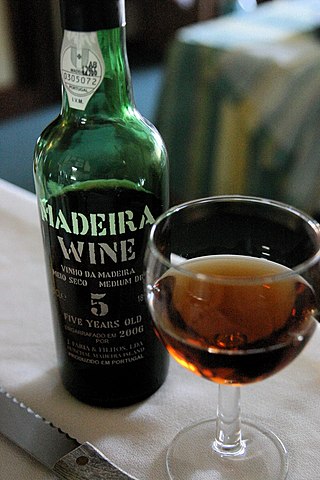
Madeira is a fortified wine made on the Portuguese Madeira Islands, off the coast of Africa. Madeira is produced in a variety of styles ranging from dry wines which can be consumed on their own, as an apéritif, to sweet wines usually consumed with dessert. Cheaper cooking versions are often flavoured with salt and pepper for use in cooking, but these are not fit for consumption as a beverage.

Malvasia is a group of wine grape varieties grown historically in the Mediterranean region, Balearic Islands, Canary Islands and the island of Madeira, but now grown in many of the winemaking regions of the world. In the past, the names Malvasia, Malvazia, and Malmsey have been used interchangeably for Malvasia-based wines; however, in modern oenology, "Malmsey" is now used almost exclusively for a sweet variety of Madeira wine made from the Malvasia grape. Grape varieties in this family include Malvasia bianca, Malvasia di Schierano, Malvasia negra, Malvasia nera, Malvasia nera di Brindisi, Malvasia di Candia aromatica, Malvasia odorosissima, and a number of other varieties.

Tempranillo is a black grape variety widely grown to make full-bodied red wines in its native Spain. Its name is the diminutive of the Spanish temprano ("early"), a reference to the fact that it ripens several weeks earlier than most Spanish red grapes. Tempranillo has been grown on the Iberian Peninsula since the time of Phoenician settlements. It is the main grape used in Rioja, and is often referred to as Spain's noble grape. The grape has been planted throughout the globe's wine regions.

Trousseau or Trousseau Noir, also known as Bastardo and Merenzao, is an old variety of red wine grape originating in eastern France. It is grown in small amounts in many parts of Western Europe; the largest plantations are today found in Portugal, where most famously it is used in port wine. It makes deep cherry red wines with high alcohol and high, sour candy acidity, and flavours of red berry fruits, often complemented - depending on production - by a jerky nose and an organic, mossy minerality.

Macabeo, also called Viura or Macabeu, is a white variety of wine grape.

Portuguese wine was mostly introduced by the Romans and other ancient Mediterranean peoples who traded with local coastal populations, mainly in the South. In pre-Roman Gallaecia-Lusitania times, the native peoples only drank beer and were unfamiliar with wine production. Portugal started to export its wines to Rome during the Roman Empire. Modern exports developed with trade to England after the Methuen Treaty in 1703. From this commerce a wide variety of wines started to be grown in Portugal. And, in 1758, one of the first wine-producing regions of the world, the Região Demarcada do Douro was created under the orientation of Marquis of Pombal, in the Douro Valley. Portugal has two wine-producing regions protected by UNESCO as World Heritage: the Douro Valley Wine Region and Pico Island Wine Region. Portugal has a big variety of local kinds, producing a very wide variety of different wines with distinctive personality.

Mencía, known as Jaen in Portugal, is a grape variety native to the western part of the Iberian Peninsula. In Spain, it is planted on over 9,100 hectares, with another 2,500 hectares in neighboring Portugal. It is primarily found in the Bierzo, Ribeira Sacra, Valdeorras, Monterrei and Dão wine regions.
Abouriou is a red French wine grape variety grown primarily in Southwest France and, in small quantities, California. It is a blending grape that, along with Malbec, Cabernet Sauvignon, Syrah, Fer, Cabernet Franc, and Merlot, is used to make the Appellation d'origine contrôlée (AOC) wine of Côtes du Marmandais. Abouriou can also be made into a varietal, as it is used in some vin de pays wines. The grape is known for its low acidity and high tannin content.

Tacoronte-Acentejo is a Spanish Denominación de Origen Protegida (DOP) for wines located in the Anaga Peninsula on the northeastern coast of the island of Tenerife. It was the first region in the Canary Islands to acquire DO status, in 1992. It covers the municipalities of Santa Cruz de Tenerife, San Cristóbal de La Laguna, El Rosario, Tegueste, Tacoronte, El Sauzal, La Matanza de Acentejo, La Victoria de Acentejo and Santa Úrsula.

Abona is a Spanish Denominación de Origen Protegida (DOP) for wines located on the southern coastline of Tenerife,, and acquired its DO in 1996.
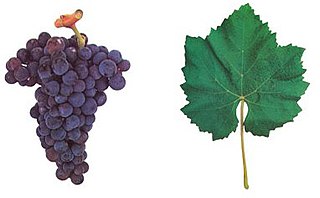
Castelão, in Portugal also known as Periquita and João de Santarém, is a red wine grape found primarily in the south coastal regions but is grown all over Portugal and is sometimes used in Port wine production.
Complexa is red Portuguese wine grape used in the production of Madeira. The grape was created as a crossing of Castelao, Muscat Hamburg and Tintinha in the 1960s. The grape provides a deep color with less tannins than the commonly used Tinta Negra Mole.
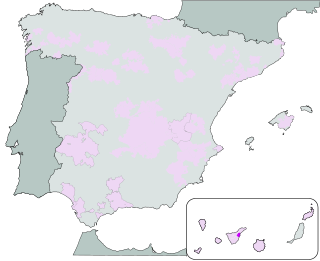
Valle de Güímar is a Spanish Denominación de Origen Protegida (DOP) for wines located along the south-eastern coastline of Tenerife, and acquired its DO in 1996.
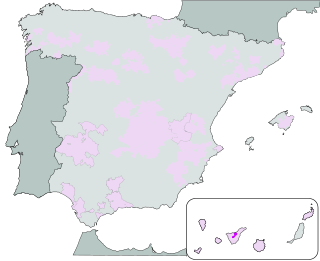
Valle de la Orotava is a Spanish Denominación de Origen Protegida (DOP) for wines located on the north-western coastline of Tenerife,, and acquired its DO in 1995.

La Gomera is a Spanish Denominación de Origen Protegida (DOP) for wines that covers the entire island of La Gomera comprising the six municipalities of San Sebastián de la Gomera, Hermigua, Agulo, Vallehermoso, Valle Gran Rey and Alajeró. It obtained its official status in 2009.

La Palma is a Spanish Denominación de Origen Protegida (DOP) for wines that covers the entire island of La Palma, in the Canary Islands, Spain. It acquired its DO in 1994. There are around 600 ha of vineyards registered with the DOP, planted in a strip along the coast, though the altitude can vary between 200 m and 1,500 m above sea-level. The DOP is divided into three sub-zones.
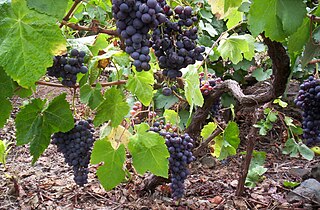
Listán Negro is a red Spanish wine grape variety that is widely planted in the Canary Islands, particularly on the island of Tenerife where it is a permitted variety in the Denominaciones de Origen (DO) wines of Tacoronte-Acentejo, Valle de la Orotava, Ycoden-Daute-Isora, and Valle de Güímar. It is also permitted in the Spanish wine regions of El Hierro, Gran Canaria, La Gomera, La Palma, Lanzarote. More than 5,000 hectares of the Listán Negro grape variety are planted across the Canary Islands.
Listán Prieto is a red grape variety that is believed to be originated from the Castilla-La Mancha region in Spain. Listán Prieto has disappeared from Spain mainland, but there are still 29 ha planted on the Canary Islands in 2008.
Forcallat tinta is a red Spanish wine grape variety that is native to the Castile-La Mancha region of central Spain, as well as in Alicante and Valencia provinces in the Valencian Community. The name of the cultivar means "forked" in Valencian, which probably refers to the bunches having a wing or shoulder, rather than a tendency to produce forked vines as suggested by Favà. It tends to produce pale-colored wines and is most often used as a minor blending component in Vino de la Tierra (VdlT) wines. It is an authorized variety in the Comunitat Valenciana, where it has become almost extinct and only a few wine makers like Rafael Cambra are making efforts to recover it, with interesting proposals like La forcallà d'Antònia. Extant plots are found in Fontanars dels Alforins, La Font de la Figuera, Villena and probably Moixent, though the cultivar was once a prevailing one in La Vall d'Albaida and Alto Vinalopó regions. Bodega la Encina in Villena (Alicante) with vineyards in neighbouring Almansa (Albacete) also works with the variety, offering wines from biodynamic and organic farming. DNA profiling conducted in the early 21st century determined that the white berried Forcallat blanca grape is a distinct variety and not a color mutation of Forcallat tinta. The white cultivar Trepadell is also called Forcallat blanc in the village of La Font de la Figuera, with only one remaining plot of about 600 plants. Trepadell is also present in the Marina Alta region and has been elaborated by Curii uvas & vinos.















